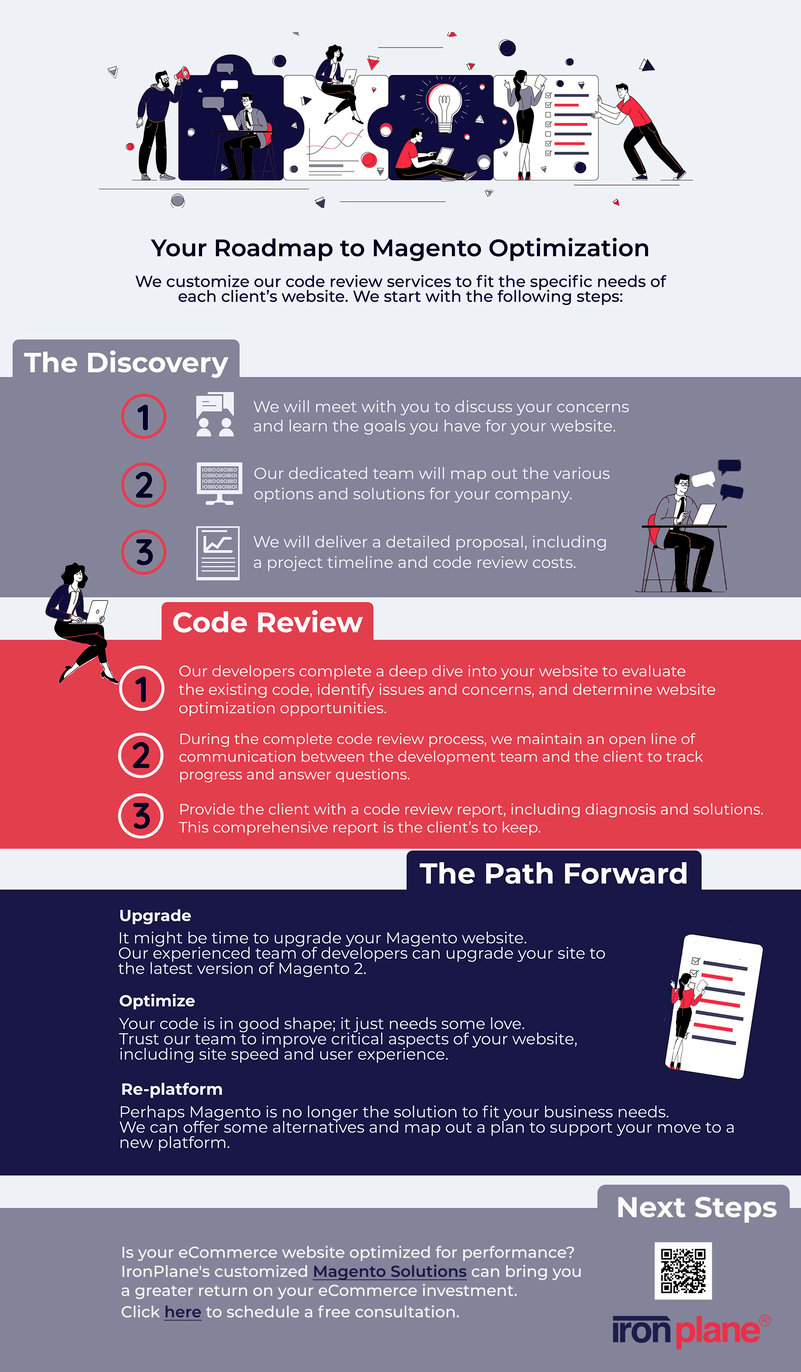Magento Site Optimization: 2024 Guide (With 5 Tips & Examples)
Our Magento site optimization guide covers best practices to improve website performance. We also review our development agency's process and case studies.
13 min read
 Tim Bucciarelli
:
January 20, 2022
Tim Bucciarelli
:
January 20, 2022

Ever since the early days of the internet and eCommerce, website builders have sought new ways to optimize their websites for greater speed, relevance, and engagement. However, the process of optimizing a website has always been a bit like shooting at a moving target. While factors such as miniaturization, mobile networking, and artificial intelligence have helped move this target in recent years, three key elements are primarily responsible for the explosive growth of the internet:
With these changes in speed and adoption come adjusted expectations. To keep up with the expectations of today's online audience, sites must be fast, intuitive, relevant, compliant, and secure. This article considers the idea of website optimization in the context of the Magento eCommerce platform.
From its early days as an open-source upstart to its current incarnation as a core element of Adobe's Experience Suite, the Magento platform has undergone continued development expanding the platform's eCommerce capabilities to meet the needs of online consumers and the businesses that serve them.
With years of experience building Magento eCommerce websites, IronPlane has developed an efficient and effective approach for optimizing Magento websites.
At a high level, we break down our areas of optimization into three buckets:
When we take on a Magento optimization project, we begin by understanding the client's needs. We identify specific optimization opportunities within each of the above buckets by conducting the following assessment activities:
These assessments allow us to establish a holistic understanding of the business, its goals, and how the eCommerce code, business processes, and user experience can be optimized to support those goals.
Magento technical optimization is driven primarily by our code review, which takes a detailed look at both the backend and frontend code that makes up the website. Following are the common areas we identify for optimization.
Magento Optimization Series. Want more insights? Visit our Shaping eCommerce with IronPlane Channel to watch our 15-part series on Magento Optimization. We release new content every week, so please subscribe to our channel and make sure to hit the notification bell.
Adobe releases Magento security updates approximately four times per year and Magento functional updates approximately two times per year. Therefore, maintaining the Magento website with the most recent core code is an essential first step in maintaining the latest functionality, consistent site stability, and security risk mitigation.
Magento uses themes as the frontend framework for the design and usability of the website. Over the years, a huge number of themes have been built for the Magento platform. Some of these themes are free, while others are paid for via a one-time fee or via an ongoing subscription.
The two basic Magento themes are Magento Luma and Magento Blank. In addition, there is any number of third-party, off-the-shelf themes to be found via a website such as themeforest.net. These base themes can be customized to meet the specific needs of each website owner.
In our experience, some themes are better than others. In some ways, this depends on your particular needs, and in other ways, it depends on whether the theme was coded well.
Areas of consideration when reviewing a theme include:
Many of our clients come to us experiencing troubles with their Magento website. Often, their existing Magento theme plays a part in these troubles, and we recommend they migrate to the open-source Alpaca theme. Our partner Snow.Dog built and maintains the Alpaca theme to optimize for speed, accessibility, and usability. In our experience, the additional benefit of our developers working with the Alpaca theme is that they are very familiar with the code of that theme and are much more efficient in the hours required for maintenance, updates, and customizations.
Magento Modules / Extensions
Beyond the core Magento code, which depends on the updates released by Adobe, and the theme, which depends on the updates released by the theme developer, the extensions or modules used for a site can have a direct impact on how well a site performs.
Similar to theme selection, website owners should look beyond the functionality offered by an extension to understand the quality of the code for compatibility, speed impacts, scalability, and reliability. This type of analysis relates to both off-the-shelf themes as well as purpose-built custom modules.
Due to the complexity of interactions between the core code, the theme, and extensions, our code review helps assess potential conflicts or inefficiencies that should be addressed with updates, code adjustments, or working with different extensions. In our experience, some developers produce consistently good extensions. The companies Amasty, Aheadworks, Mirasvit, and Mageplaza, are examples of developers of quality Magento extensions.
After more than 10 years designing and developing Magento eCommerce environments for our clients, and in the interest of minimizing the challenges of poorly coded or implemented extensions, IronPlane developed a new Magento foundation. This foundation aims to provide a highly customizable and reliable eCommerce experience using the Alpaca theme and a carefully curated selection of extensions and modules. This foundation was given the name Colibri, which is the Spanish word for hummingbird, chosen by our developers for the foundation's lightweight code profile and speedy performance.
As a hosted eCommerce solution, Magento's server infrastructure can play a critical role in the availability, speed, and scalability of the platform. Magento hosting setups are likely to be one of the following:
These days, on-premise is the least common hosting setup for Magento due to its high cost, technical complexity, and skilled support staff required. In businesses with highly-specialized requirements, this scenario may make sense, but for most companies, managed hosting or cloud hosting offer better value.
Managed hosting companies offer a managed server infrastructure with servers that are either shared across several client websites or dedicated to a single client website. Costs for a shared environment are lower, and resource allocation depends on a variety of factors mostly out of a client's control. Costs for a dedicated environment are higher, but with dedicated resources, and a properly sized server, a business can have a more reliable experience.
Cloud hosting has grown in popularity over the past several years with improvements in reliability, scalability, and cost. Amazon's Web Services (AWS) are one of the most popular cloud platforms, but Google and Microsoft are also heavily invested in this type of infrastructure as a service. Cloud subscriptions allow a pool of resources to be accessed efficiently by a pool of users, and this use is optimized by highly sophisticated load balancing. As long as the initial resource subscription is sufficient for your needs, this cloud setup offers a highly reliable and scalable solution that is often price competitive with dedicated server options.
The choice of hosting environment is typically driven by business needs and preferences. Within each of those environments, some setups and configurations should be reviewed for optimization opportunities. These areas include:
Business optimization puts the focus on the operational areas of your business. These include integration opportunities with other technologies used by the business, supporting operational workflows, and ensuring compliance with important regulatory requirements.
Integrations with existing systems can help businesses limit the amount of work necessary to maintain accurate data system-wide. While the goal of a single source of truth may not always be fully realized, reductions in duplicate data activities can be achieved through thoughtful integrations between your Magento website and your ERP, CRM, PIM, and other systems that touch your product, customer, or transactional data.
Understanding the operational workflows of a business helps us identify ways the Magento platform can improve efficiency. Here are a few examples:
Considerations such as these play an important role in helping a business optimize its Magento eCommerce platform.
While some businesses have regulations applicable to their particular industry or product category, most businesses have at least the following three compliance areas to consider:
PCI compliance is considered in the core code of the Magento eCommerce platform, but there are important steps that should be taken to ensure ongoing compliance. One such example is keeping the Magento platform up to date. Others include maintaining up-to-date SSL credentials and ensuring secure website forms, which receive sensitive information from your customers.
ADA compliance and the EU's WCAG are more complex to implement and maintain website accessibility. We advise making use of ADA compliance best practices at the earliest stages of the website design. Once built, we suggest conducting user testing for practical compliance analyses. For ongoing compliance, protocols should be put in place for code, content, and design changes to ensure they are properly implemented.
Online consumer privacy is more of a moving target when compared to the federal ADA requirements. According to this Wirecutter article in the New York Times:
The United States doesn't have a singular law that covers the privacy of all types of data. Instead, it has a mix of laws that go by acronyms like HIPAA, FCRA, FERPA, GLBA, ECPA, COPPA, and VPPA.
The best advice for companies that operate online and target customers throughout the US is to aim for compliance with the most restrictive state regulations. Unfortunately, at this point, only a few states have such privacy laws in place, and a good reference example is California's CCPA and its associated amendment CPRA.
As with ADA, privacy compliance should be built into the design and ongoing maintenance of a website. As regulations are likely to change over time, staying abreast of those changes will remain an ongoing need.
PCI DSS compliance is a well-known, documented, and supported requirement. However, there is a broader need for overall site security that must be considered. To understand why to consider these facts:
In the past, optimizing a website to offer proactive risk mitigation, monitoring, and notification was an expensive effort implemented by resource-rich or high-risk companies. We advise all of our clients to follow these five best practices for optimizing the security of their Magento eCommerce platform.
3. Work with a hosting company that offers strong security features
4. Implement best-in-class site monitoring tools (e.g. Sucuri or Sansec Ecomscan)
5. Implement firewall (e.g. Cloudflare Web Application Firewall)
There is no silver bullet for eCommerce site security; there is only risk mitigation. The more sensible steps you can take to mitigate your risk of being the victim of a hack or ransomware, the better off you will be.
In this area of Magento optimization, we consider several key optimization opportunities. While there is a lot of overlap, this breakdown helps clarify the impacts Magento design, data, and configuration can have on overall site success.
Before considering optimization efforts, it is important to understand existing benchmarks and analyze progress against these benchmarks over time. We do this by ensuring analytics tools are properly implemented to provide the data necessary to make informed optimization decisions.
At a minimum, we make sure the following analytics tools are in place and tracking accurately:
We often recommend paying particular attention to configuring these tools to reflect your specific audience/funnel flow so that you are tracking activities that better align with your sales practices.
Additional analytics tools may be used for tracking and optimizing advertising, social media, SEO, usability, or marketing activities.
The speed of a website is one of the most important characteristics of a website. At the very basic level, online buyers, even with the strongest intent to find your website, have a low tolerance for a slow website. For example, research conducted by section.io found that 9.6% of site visitors will leave a page if it loads within 2 seconds. For pages that load in 7 seconds, the bounce rate jumps to more than 32%. You can imagine the impact this will have on conversion rates and customer experience.
Site speed is also an element considered by Google when it ranks sites for organic searches. If your site is slow (desktop or mobile), it gets a lower score than others who perform better. Two of Google's three key performance metrics are Largest Contentful Paint (LCP) and First Input Delay (FID), both of which are directly related to the speed with which your site loads and displays information.
Magento has a history as a robust but heavy eCommerce platform. While the launch of Magento 2 improved native site speed, Magento's performance should be optimized by a skilled developer.
Here are the top 10 ways you can speed up your Magento site:
Taking the time to effectively optimize your Magento website's speed is one of the smartest investments you can make and will likely have a positive impact on SEO, usability, and conversion rates.
Want a Free Speed Test?
Visit our Magento 2 Speed Optimization page and submit the form.
Mobile Optimization
Our clients span industries and business models with B2B, DTC, B2C, and various hybrids. Even in the most traditional online business environment, we see mobile users accounting for at least 60% of online traffic. It is not uncommon to see that percentage hit 80% for consumer-based websites. This is a global trend that is only accelerating:
If your Magento website is not optimized for mobile today or if you do not have a plan to optimize for mobile in the future, you are putting a large part of your customer population at risk as they look for mobile-ready websites to engage with and buy from.
As described above, we make use of Google Search Console to understand a site's performance relative to visitor searches. Using the data from this tool, we identify areas of the website that can help improve SEO results. Questions we attempt to answer include:
Rich results (formerly Rich Snippets) are the result of information Google collects from a properly configured website for richer search results presented prominently on a search results page. Rich results are generated algorithmically using structured data markup you include on relevant pages of your website. If the markup on a page offers an accurate description of the page's content, is up-to-date, and is visible and easily discoverable on your page by users, Google's algorithms are more likely to decide to show your rich result in Google's search results. For more on Rich Results, visit Google's gallery of Rich Result samples.
Magento's product feed is an essential part of strong SEO. When a user is searching online for a particular product, Google's first page of search results often presents a carousel of relevant product data, including images, reviews, and prices. Additionally, the Google shopping tab presents a much more comprehensive selection of relevant products. These areas are highly competitive and depend in large part on the effective use of structured data in your Magento product feed.
If a site is fast, has good SEO, and has strong mobile readiness, it is not necessarily optimized for usability. We break usability down into three primary areas:
User experience is a distinct discipline in the world of design. UX analysis is the process we use to understand a client's audience. To do this, we analyze the business, its stakeholders, and its customers to build customer profiles and the journeys they take to find, engage and purchase from the business.
This analysis allows us to advise the design team with practical strategies for optimizing visitor engagement and conversion.
The reason fast site speed is so essential to a website's success is that visitors have a low tolerance for spending time inefficiently online. The site must load quickly, but it must also help them find what they want quickly. The first area to consider optimizing to achieve this goal is your product taxonomy and merchandising.
Taxonomy is how you structure your product assortment. Most often, it is a two-level structure of product categories broken down into a list of products. For more complex product sets, you might add a subcategory to the mix. However you build your taxonomy, it must be clear, logical, and easy to navigate.
Taxonomy's partner in crime, so to speak, is on-site search. This function is made up of two elements: the text search function and the product filter / refine function. Each of these two areas can be configured within a base Magento implementation using Elastic Search.
The text search function can be configured to support auto-complete, search synonyms, redirects, attribute weighting, and suggested search results based on what was entered.
The category/product taxonomy provides the high-level breakdown of products, but users often want to further refine their searches using key product attributes. Common filters include price, rating, and availability. In some unique product types, specific attribute filters can dramatically improve your site's usability - this type of information is what usually comes out of the UX analysis mentioned above.

There are a lot of opportunities to optimize your Magento website. If you are unsure where to begin, consider a single action as your first step in the right direction: a thorough Magento code review. Our code review provides an unbiased view of your current Magento website, the issues we see limiting its success, and the opportunities for optimization.
Our dedicated Magento Performance Optimization team is ready to boost your Magento 2 eCommerce platform's speed, conversions, and stability. Click here to learn more and schedule your free consultation.
Performance optimization is critical because faster websites provide a better user experience, which directly impacts customer satisfaction, search engine rankings, and sales. A slow-loading website can lead to higher bounce rates, lower search engine visibility, and reduced conversions. Optimizing your Magento store ensures it can handle traffic spikes and maintain smooth functionality as your business grows.
Key strategies for optimizing Magento performance include enabling full-page caching, optimizing images, using a content delivery network (CDN), upgrading to a powerful hosting environment, and minimizing the use of heavy extensions or customizations. Regularly updating Magento and its extensions, optimizing database queries, and reducing JavaScript and CSS file sizes are also essential practices for improving performance.
Yes, Magento performance optimization can significantly improve mobile performance. Techniques like optimizing images for mobile, using responsive design, and minimizing heavy scripts help ensure that your Magento store loads quickly and functions smoothly on mobile devices. Given the increasing number of customers shopping on mobile, optimizing your store for mobile performance is crucial for success.
Signs that your Magento site may need performance optimization include slow page load times, frequent site crashes during high traffic periods, high bounce rates, and low conversion rates. You can use tools like Google PageSpeed Insights, GTmetrix, or Magento’s own performance toolkit to analyze your site’s speed and identify areas that need improvement.

Our Magento site optimization guide covers best practices to improve website performance. We also review our development agency's process and case studies.

Elevate your ecommerce store with insights into high-performing Magento websites. Explore B2C and B2B examples, key features, and optimization strategies.

Learn how to optimize the Magento user experience, from site navigation to performance, to category organization, to product details, to compelling copy.